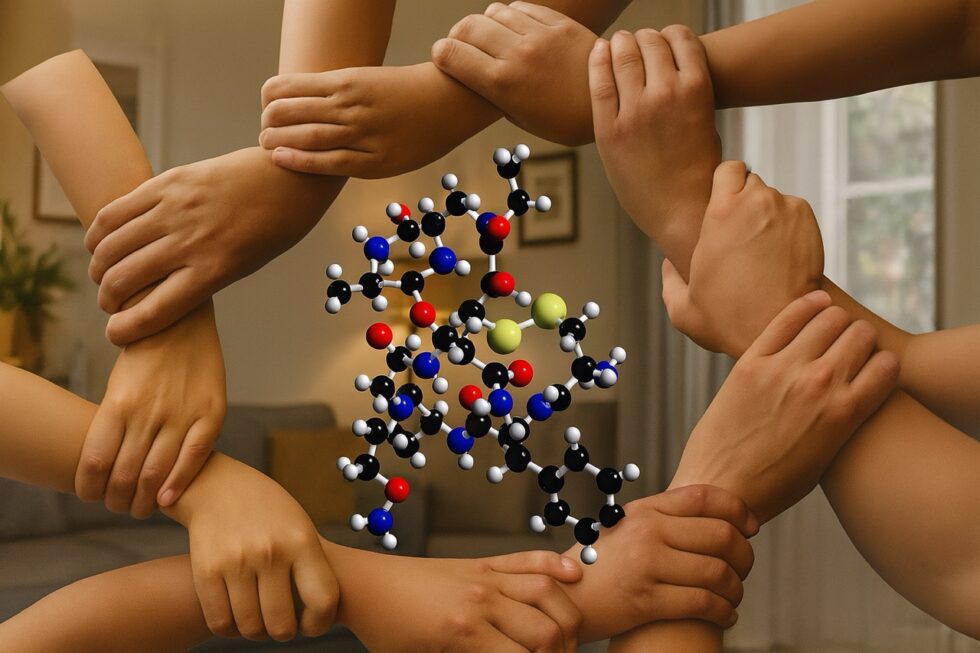Oxytocin: How the Hormone Regulates Trust, Stress Resilience and Healing in the Body

Oxytocin is a neurohormone produced in the hypothalamus and released into the bloodstream by the pituitary gland. Long regarded primarily for its role in childbirth and breastfeeding, it is now recognized as a key regulator of social bonding, emotional regulation, and psychological resilience. Though invisible and silent in its action, oxytocin influences how we build trust, form attachments, and recover from stress. Its significance is increasingly acknowledged in modern neuroscience and trauma therapy, where it is studied as a crucial component in the body’s ability to connect, heal, and stabilize under pressure, as reported by G.Business.
Its best-known function lies in obstetrics: it induces labor, stimulates milk flow, and strengthens the early bond between mother and child. But its effects go far beyond that. Oxytocin influences stress regulation, supports tissue healing, reduces inflammation, and plays an essential role in social relationships.
What Exactly Does Oxytocin Do? – A Scientific Comparison
| Condition | Low Oxytocin Level | High Oxytocin Level |
|---|---|---|
| Stress Regulation | Elevated cortisol, inner restlessness | Faster relaxation, improved sleep |
| Relationship/Bonding | Withdrawal, mistrust, fear of attachment | Trust, empathy, emotional openness |
| Wound Healing | Slower cell regeneration, risk of infection | Faster healing, anti-inflammatory response |
| Social Behavior | Isolation, low tolerance for closeness | Group integration, communicative engagement |
| Emotional Balance | Mood swings, emotional overload | Stability, improved self-awareness |
Oxytocin in Women: Emotional Regulation
In women, oxytocin is hormonally linked to estrogen, meaning its intensity and effect vary throughout the menstrual cycle. During breastfeeding, for example, oxytocin is released through skin contact or even the sight of the baby. It not only calms the infant but also reduces the mother's blood pressure, promotes uterine recovery, and protects against postpartum stress.
Case study: A study from the Max Planck Institute found that women who received family support during breastfeeding experienced fewer depressive symptoms, slept better, and reported higher self-confidence – all correlated with higher oxytocin levels.
Practical tip: Women going through hormonal transitions (e.g., after childbirth, stopping the pill, menopause) can stabilize their cycle and immune system by consciously seeking physical and emotional closeness – through friendships, a partner, or therapeutic touch.

Oxytocin in Men: Focus, Bonding, and Anti-Stress Effects
In men, oxytocin plays a particularly important role in father-child bonding and in long-term relationships. While testosterone is often associated with dominance and competition, oxytocin lowers irritability, increases patience, and encourages what's known as social grooming – bonding through care.
Neurological insight: Oxytocin inhibits the amygdala (the brain's fear center) and activates the prefrontal cortex, which is responsible for empathy and impulse control.
Example: A Norwegian longitudinal study found that men who regularly cuddled with their children reported less aggression, greater stress resistance, and more emotionally balanced relationships – even years later.
Tip: Daily physical contact with family – such as cooking together or hugging – has a hormonal effect on men comparable to that of sleep or exercise.
How to Recognize Oxytocin Deficiency
Oxytocin deficiency doesn’t cause sudden symptoms – rather, it unfolds gradually over weeks or months and affects mental, emotional, and social stability.
Typical signs include:
- Persistent emotional exhaustion despite adequate rest
- Reduced enjoyment of physical closeness or intimacy
- Emotional numbness or mistrust of close relationships
- Irritability, poor sleep, heightened pain sensitivity
- Withdrawal from relationships for no clear reason
Medical relevance:
Low oxytocin levels are significantly more common in individuals suffering from depression, PTSD, autism spectrum disorders, and chronic pain.
How to Increase Oxytocin – Practical Ways
Importantly, oxytocin is not released through effort or performance, but through meaningful interaction. It is a social hormone, activated by trust, safety, and genuine connection.
Scientifically Proven Methods to Boost Oxytocin
- Long, mindful hugs (at least 20 seconds)
→ Leads to immediately measurable oxytocin release - Positive physical contact (daily)
→ Touches, massages, cuddling can increase levels by up to 25% - Eye contact and attentive conversation
→ Stimulates reward centers and lowers anxiety - Petting animals
→ Especially dogs trigger a strong hormonal response - Practicing gratitude
→ Journaling or verbal appreciation sustainably raises oxytocin - Group singing or prayer
→ Rhythmic synchrony enhances emotional bonding - Heart-centered meditation
→ Activates the parasympathetic nervous system and promotes calm
How Fast Does Oxytocin Work
According to a 2021 study by the University of Freiburg, oxytocin becomes measurable in the bloodstream within 30 to 90 seconds after skin-to-skin contact. Under intense triggers like childbirth or sexual activity, oxytocin levels can rise to three to five times the normal level.
Its biological half-life in the bloodstream is 3 to 5 minutes, but the neurological effect in the brain can last up to 90 minutes, depending on emotional safety and connection.
Why Artificial Oxytocin Doesn’t Always Work
Oxytocin nasal sprays are used medically to induce labor or experimentally in psychiatry. But studies show that the hormone has limited effect unless supported by emotional context and interpersonal trust.
Clinical observations:
- Effective in autism or PTSD only when combined with therapy
- No lasting benefit in couple dynamics without emotional support
- Risk of emotional misattachment to unreliable people
- Misuse can cause headaches, nausea, confusion
Conclusion: Oxytocin is a biological amplifier, not a shortcut to emotional connection.
Oxytocin Is a Key to Emotional Resilience
Oxytocin is not a miracle drug – but it is one of the body’s most powerful tools for psychological and social resilience. People who regularly experience positive, emotionally meaningful interactions are not only more trusting and balanced – they are also physically healthier, more stress-resistant, and better equipped to maintain relationships.
In an increasingly digital world, oxytocin remains one of the last natural anchors for real closeness and emotional health.
Stay connected for news that works — timely, factual, and free from opinion. Learn more about this topic and related developments here